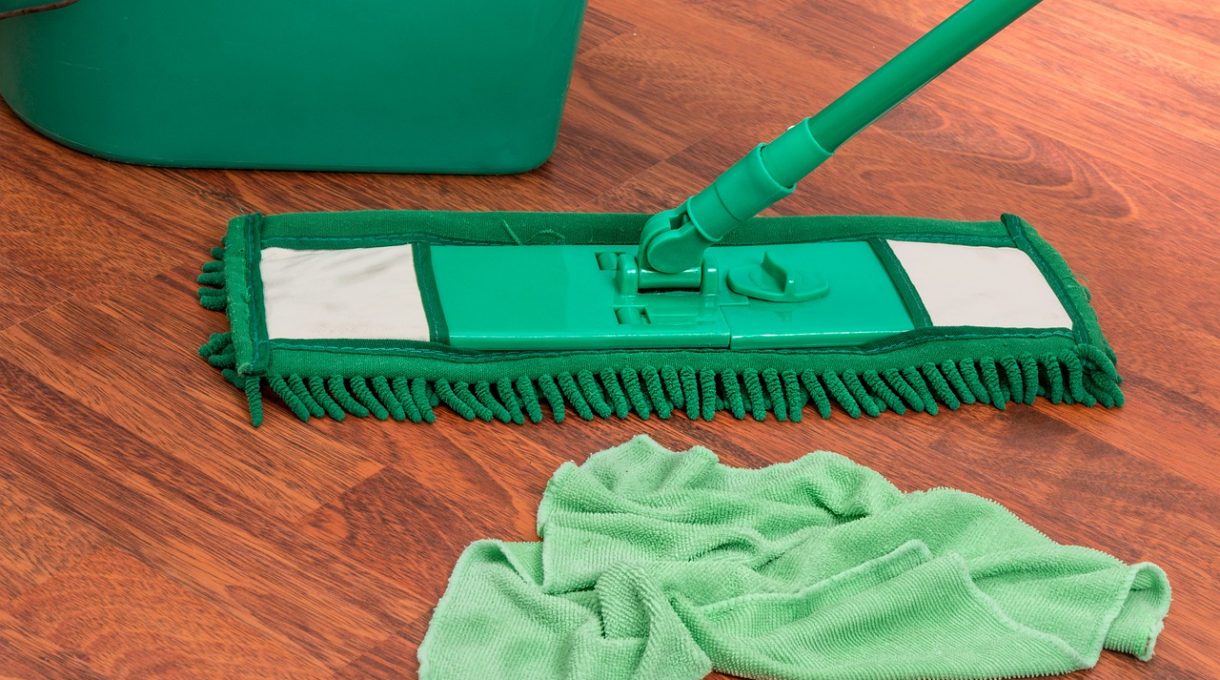You don’t have to buy expensive, strong-smelling products to keep that floor spotless and looking good as new. Green-friendly cleaning products abound, and some are already in your house.
- HGTV suggests boiled water and teabags. Steep two teabags in a pot full of water for a couple of minutes and pour this into a bucket. When it’s cool enough to not burn you, dunk in a soft cloth and wring it out. Wash the floor with the damp cloth to get a beautiful shine courtesy of the tannic acid in the tea.
- Care2, a site that promotes healthy, green lifestyles suggests adding 1/4 cup of mild liquid dish washing detergent (preferably chemical-free) to a bucket of warm water for damp mopping. A little bit of baking soda on a damp sponge can safely rub out scuff marks.For floors finished with oil or wax, use a natural solvent-based cleaner. White spots left by spilled water can be gently buffed out with fine steel wool and a couple of drops of the solvent.
- Gaiam Life, another healthy lifestyle and green site, suggests adding a half-cup of pure lemon juice into a bucket for damp mopping to remove mildew, odors, grease, and wax buildup. Olive oil added to damp-mop water will condition unfinished floors.
The Vinegar Debate in Green Cleaning
Vinegar has become the Green Cleaner of the Decade. Various sites endorse it for lime descaling in appliances, general housecleaning, steam cleaning microwave ovens, and stain removal on carpets, clothing, and shoes.
What About Hardwood Floors?
Green sites tend to agree vinegar is safe on wood but some professional cleaning sites warn against it, saying it’s too harsh on finishes and can void warranties. This may stem from a universal warning against letting water puddle on hardwood floors during cleaning. The two don’t mix well for long periods of time; any spills on a hardwood floor should be cleaned up immediately to avoid discoloration and warping.
Likewise, be sure to damp mop and not slosh. So adding a little vinegar to the mix won’t do harm to a floor in good shape. If there are objections to the vinegar smell, it dissipates quickly. Dust mopping is also recommended.
Options to Mopping
Mopping isn’t fun and many people look to steam cleaners, which clean with super-heated water and no chemicals, to do the job. But is this safe on hardwood floors?
The general answer is: no. There are too many variables: steam harms finishes, leaves streaks, warps untreated wood floors, and can deliver too much steam at once, which can let moisture seep in between the floorboards.
Your best bet? Ask people to take off their shoes when they enter your home. Put nonslip rugs on high-traffic areas, and sweep and damp-mop regularly with your favorite green wood floor product.
The Author:
Jillynn Stevens is a writer and researcher. For new hardwood floors and wood floor maintenance, consider Wharton Hardwood Floors in and around Salt Lake City, Utah.
Photo. Stevepb

Dear Sirs.
I have new hardwood floors and would like to know how to remove patches of medicated body moisture which remains on the floor after cleaning. I have tried washing up liquid in warm water followed by a light cleaning with vinegar in warm water. However after drying off the affected areas the floor still displays the moisture patches.
Is there any solution you can suggest please.
Kind regards
Joan
Hello Joan,
Navigating the issue of moisture marks on hardwood floors can indeed be tricky. From what you’ve described, it appears the medicated body moisture has created a stubborn residue that isn’t fully cleared by standard cleaning agents like dish soap or vinegar. Here are some alternative strategies you might find useful:
Moisture Assessment: Utilizing a moisture meter to gauge the level of moisture in your hardwood floors could provide insight into whether the issue is on the surface or deeper within.
Homemade Remedies: For persistent stains, a homemade paste using common ingredients could be effective. A light stain might be addressed with a blend of baking soda and water. Spread the mixture gently, allow it to settle for a short period, then clean it away.
Vinegar Application: Tackling more pronounced stains might require distilled white vinegar. Drench a cloth in the vinegar and lay it over the stain for several minutes. It may take a few applications to fully eradicate the stain.
Expert Consultation: Should the moisture spots remain, it’s advisable to seek the expertise of a hardwood floor specialist. They can offer a tailored solution that safeguards the integrity of your new flooring.
It’s crucial to test any cleaning method on a small, hidden section of your floor to prevent any potential damage.
Wishing you the best in reviving the natural allure of your hardwood floors.